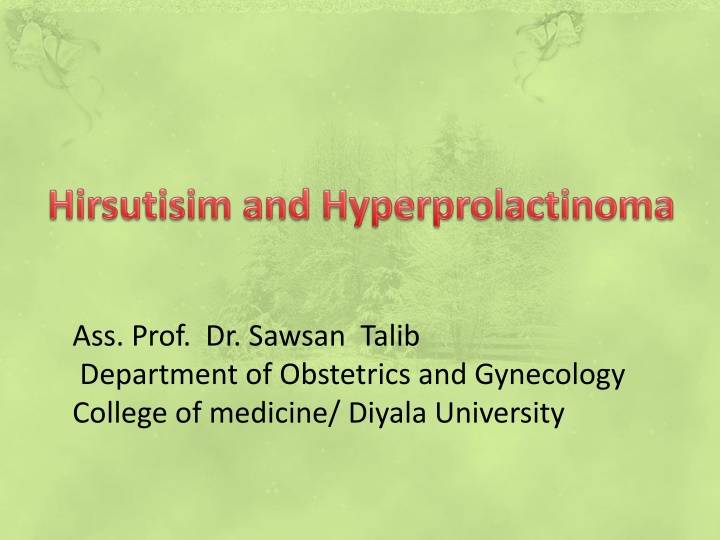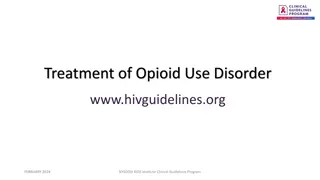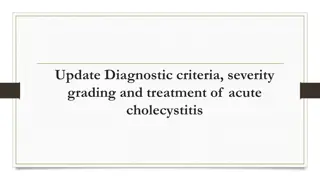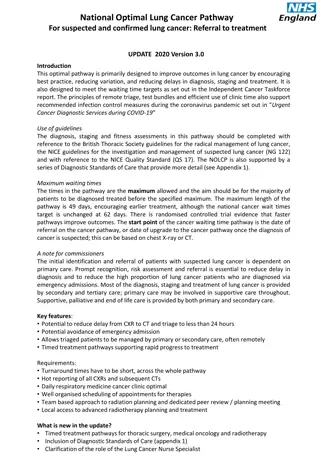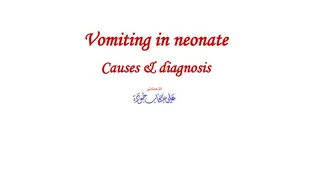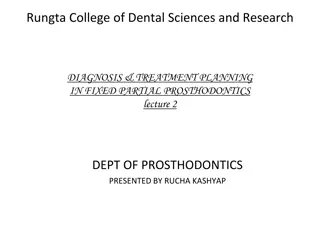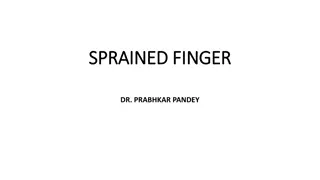Hirsutism: Causes, Diagnosis, and Treatment
Differentiate hirsutism from virilism, analyze history and examination, outline investigations needed for diagnosis, and describe treatment options. Explore definitions and mechanisms of excessive hair growth in the context of hyperandrogenism and hypertrichosis. Gain insights into the pathophysiology of hirsutism through hormonal factors like plasma testosterone, SHBG, free testosterone, and 5-alpha-reductase activity.
Download Presentation

Please find below an Image/Link to download the presentation.
The content on the website is provided AS IS for your information and personal use only. It may not be sold, licensed, or shared on other websites without obtaining consent from the author.If you encounter any issues during the download, it is possible that the publisher has removed the file from their server.
You are allowed to download the files provided on this website for personal or commercial use, subject to the condition that they are used lawfully. All files are the property of their respective owners.
The content on the website is provided AS IS for your information and personal use only. It may not be sold, licensed, or shared on other websites without obtaining consent from the author.
E N D
Presentation Transcript
Ass. Prof. Dr. Sawsan Talib Department of Obstetrics and Gynecology College of medicine/ Diyala University
Learning objectives Differentiate the hirsutism from virilisim. Determine the severity by using ferriman gallway score. Understand the sources of androgen in the body. Classify the causes of hirsutism. Analyze history and edxamination to predict the cause of hirsutism. Outline the investigations required for diagnosis. Describe the treatment of hirsutism case
Definitions Hirsutism: Hirsutism APPEARANCE OF EXCESSIVE COARSE (TERMINAL)HAIR IN A PATTERN NOT NORMAL IN THE FEMALE in facial and central part of the body that worries the patient Hypertrichosis: Hypertrichosis GROWTH OF HAIR IN EXCESS OF THE NORMAL WHILE LIMITED TO A NORMAL PATTERN OF DISTRIBUTION It is frequently associated with the use of medication such as antiepileptics Hyperandrogenism: Hyperandrogenism is a state of increased serum androgen level with or without any biological effect of hyperandrogenemia Virilism: Virilism is defined as the presence of any one or more of the following features deepening of the voice, temporal balding, amenorrhea, enlargement of clitoris (clitoromegaly) and breast atrophy. It is a more severe form of androgen excess. Virilism may be due to adrenal hyperplasia or tumors of adrenal or ovary.
Mechanism of Excessive Hair Growth The stimulus for the excessive hair growth is testosterone. Testosterone binds to the androgen receptors in the hair follicle. This is followed by activation of the enzyme 5 - reductase. This will convert testosterone to most potent androgen dihydrotestosterone (DHT) and androstenediol which stimulate proliferation and growth of terminal hair (anagen phase). Once the black terminal hair is produced
the changes persist even in the absence of a continuing androgen excess. Increased hair follicle stimulation and increased 5 -reductase activity enable prohormones DHEA and androstenedione to be metabolized directly to DHT. This latter phenomenon explains continued growth even if the initiating testosterone source has been removed.
Pathophysiology of hirsutism T Plasma T SHBG Free T 5 -reductase activity in hair follicle DHT Hirsutism
virilism is almost always associated with hirsutism (except at birth) but hirsutism may not be associated with virilism. There may be racial or familial link.
Clinical features: In order to maintain consistency of diagnosis and to monitor therapeutic intervention, it is important to have a standard grading system. The most common is the Ferriman & Gallwey grading system, which scores 11 areas of the body on a scale of 1 to 4 according to the degree of terminal hair growth. The scores then added together.
Diagnosis History Onset of hirsutism 1) Gradual onset of hirsutism is associated with acne, oily skin, weight gain, and irregular menstrual cycles. This suggests an underlying endocrine condition, such as polycystic ovary syndrome (PCOS). 2) Abrupt onset or rapidly worsening hirsutism with signs of virilization should prompt concern for an androgen-producing tumor.
Presence or absence of virilization Drug ingestion. Drugs are usually associated with hypertrichosis, but androgenic drugs (e.g., steroids and phenytoin) may cause hirsutism. Family history. A family history of hirsutism may indicate an inherited disorder (i.e., familial hypertrichosis). Ethnic background. The pattern of hair growth is genetically predetermined and is associated with differences in 5 -reductase activity at hair follicles. Local trauma. Changes in skin and hair growth may occur.
Regularity of menstrual cycles 1. Patients with regular menstrual cycles and hirsutism often have idiopathic, ethnic, or familial hirsutism. 2. Some anovulatory hirsute patients (as many as 40%) appear to have regular menstrual cycles; thus, testing is necessary to determine whether ovulation is occurring. History of infertility
2.Physical examination The most sensitive marker for increased androgen production is 1.hirsutism. Followed in order by: 2. acne 3.oiliness of the skin, 4. increased libido, 5. clitoromegaly, and finally,masculinization.
ACNE Whiteheads, blackheads, papules, pustules, and nodules. Several areas, the face, chest, and back. Abdominal, Pelvic ex. For adrenal, ovarian tumors . Skin ex. foracanthosisnigricans.
Management Principles of Hirsutism To remove the source of excess androgen. To suppress or neutralize the action of androgen. To remove the excess hair.
Weight reductionis an important step of management. Weight loss is associated with reduction of hyperinsulinemia and androgen excess. Ideal body mass index (BMI) should not be more than 25. Removal of the source Adrenal or ovarian tumor should be surgically treated. Cushing s disease can be treated by adrenalectomy, radiation to the pituitary or removal of ACTH producing tumor by transsphenoidal surgery. In iatrogenic cases, the offending drug should be stopped.
To suppress or neutralize the excess androgen action The drugs used depending upon the site of production of excess androgens are : Combined steroidal contraceptive pill. suppress ovarian androgen activity & increase sex hormone binding globulin, thus decreasing free testosterone ex.Dianette (combined OCP with the antiandrogen cyproterone acetate) Antiandrogens
Dexamethasone. It acts by suppressing pituitary- adrenal axis. It is used in adrenal or mixed adrenal and ovarian hyperandrogenism. The dose varies from 0.25 1 mg daily at bed time. Anti-androgens Cyproterone acetate: decrease ovarian androgen. Spironolactone: is an oral aldosterone antagonist with antiandrogenic properties. Flutamide: antiandrogen. Finasteride: 5 -reductase inhibitor.
Evaluation Biological evaluation of related hormonal axes: Careful drug history and physical examination TFT, RFT PCO and exclusion of pregnancy
Diagnosis of Hyperprolactinemia Measurement of serum prolactin levels and must depend on the following criteria to measure PRL that includes: PRL levels are drawn in the morning. Prior to testing, breast examination is avoided to prevent false-positive results. If a mildly elevated PRL level is found, sampling should be repeated because PRL levels vary throughout the day. Moreover, many factors including the stress of venipuncture may produce false elevations.
Levels of prolactin <1000 m U/L <5000 m U/L > 10,000 m U/L stress Micro-prolactinoma Macroprolactinoma hypothyroidism Pituitary stalk disconnection PCOS
Evaluation for hypothalamic- pituitary pathology Clinical examination: assessment of visual fields Imaging : MRI /CT Pituitary microadenoma < 10mm Pituitary macroadenoma > 10 mm Pituitary stalk lesions Hypothalamic tumours, granulomas
Pituitary Adenomas Pituitary adenomas are the most common cause of acquired pituitary dysfunction and comprise approximately 10 percent of all intracranial tumors. Clinically, symptoms of galactorrhea, menstrual disturbances, or infertility may lead to its diagnosis. Most tumors are benign, with only an estimated 0.1 percent of adenomas developing into frank carcinoma with metastasis Nevertheless, pituitary adenomas may cause striking abnormalities in both endocrine and nervous system function
Pituitary Adenoma Symptoms Endocrinopathy Pituitary adenomas may cause symptoms via excess hormone secretion and lead to clinical conditions such as Hyperprolactinemia, Acromegaly, or Cushing disease. Alternatively, adenomas may result in hormone deficiency due to damage of other pituitary cell types or of the pituitary stalk by an expanding adenoma or following treatment of the primary lesion.
The anterior pituitary gland borders both the optic chiasm and cavernous sinus. Disruption of the optic chiasm by suprasellar growth of the pituitary mass may present as bitemporal hemianopia in which patients lose of the outer portion of the right and left visual fields
Pituitary Adenoma Diagnosis Although computed tomographic (CT) scanning provides useful information on tumor size, bony artifacts may limit interpretation. Therefore magnetic resonance (MR) imaging has become the primary radiologic method due to its high sensitivity and excellent resolution .
Treatment of prolactin-secreting pituitary adenoma Medical Surgical Radiotherapy
Indications To suppressive abnormal lactation To restore ovarian function Protection against development of osteoporosis Rx may not be required in a few women with modest elevations of prolactin, may retain normal ovarian function and have few symptoms
Bromocriptine Cabergoline Quinagolide 1stdopamine agonist since early 1970 New, high affinity for lactotroph dopamine receptors 1-2x/week 0.5-2 mg/wk Improved efficacy and few side effects NEJM 94; 331: 904-909 Most effective in reducing tumor size JCEM 2000 85 2247-2252 2-3 x/day 5-30mg/day (7.5mg/d) Nausea, postural hypotension, dizziness, headache, depression Once daily 0.05-0.25 mg Start with low dose and increase dosage gradually. Start 0.625 mg Nocte Duration 2-6 years?
Pregnancy Warned that restoration of ovulatory menstrual cycle within weeks Advised to use mechanical form of contraception until 2 regular menstrual flow Stop dopamine agonist as soon as pregnancy is confirmed for microadenoma, risk of pituitary enlargement is low <2% Bromocriptine can cross placenta and suppress pituitary prolactin secretion, but no apparent risk of congenital abnormality or misscarriage JCEM 97 82 996-1000
For macroadenoma, bromocriptine is advised during pregnancy to avoid significant tumor expansion as risk of enlargement is 15-30% (J Reprod Med 99; 44: 1121-6) Some recommend debulking for macroadenoma which have extended beyond the sella before pregnancy and bromocriptime prescribed throughout pregnancy (Am J O&G 83; 146:935-8) Cabergoline should not be used as a therapy for infertility until more information is available
Surgery Neurosurgery is required for refractory tumors or those causing acutely worsening symptoms. Radiation therapy may be used for patients with surgically nonresectable or persistent tumors. Gene therapy has been proposed as a treatment for pituitary tumors
